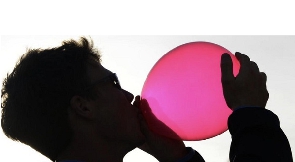Ghana, in 2017 dealt with the menace of tramadol abuse in the youth. It was a campaign that involved traditional leaders, clergy, media and regulators. The drug was abused by youth for recreational activities while others took it for extra energy for manual work.
Another emerging drug used by the youth mainly for recreational activities is nitrous gas, popularly known as laughing gas.
What is Nitrous Oxide (laughing gas)?
Nitrous oxide (N 2 O), popularly referred to as laughing gas or happy gas, was first discovered in 1793 by the English scientist Joseph Priestley and has been used for over 150 years. It has remained among the most widely used anaesthetics in dental and medical applications.
Nitrous oxide is a small inorganic chemical molecule and may also be known as dinitrogen oxide or dinitrogen monoxide. It is colourless, with a slightly sweet odour and non- flammable gas. Even though it is non-flammable, it aids combustion just like oxygen.
It is named one of the poisonous Green House Gases that is emitted into the environment, which leads to global warming.
What was it originally use for?
According to PharmD. Baba Abdulai Issa, it is mainly used for three purposes:
As anaesthesia which blocks the pain receptors from transmitting pain to the brain and works as morphine. This helps mainly in a surgical process to prevent excessive pain in patients.
It is also used as an analgesic. This is where nitrous oxide is administered in very small amounts/dosages to prevent pain. They serve as painkillers to deal with minor bodily aches.
It activates GABA receptors which cause calmness and relieves anxiety.
Generally, laughing gas is a sedative or anaesthetic which is used in medical procedures, predominant in dentistry. It helps to relieve anxiety and makes patients less tense during sessions.
It, however, does not make patients sleep. It is sometimes used to treat people
who are withdrawing from alcohol usage.
Other non-medical uses
Nitrous gas is used as a food additive as a propellant for whipped creams. It helps propel food from containers and bottles. Laughing gas is also used in the automotive industry to improve engine performance.
Medium of presentation
Nitrous oxide comes in non-refillable steel bulbs. It contains about ten ml of nitrous oxide in liquid form under pressure, equivalent to four litres of gas under normobaric (normal barometric pressure equivalent to sea level) conditions.
Medium of usage by abusers
According to the Head of Enforcement at the Food and Drugs Authority, Volta Region, Issaka Nii Amu Collison-Cofie, for recreational use, the gas is discharged into balloons and inhaled by the patrons(abusers).
Medium of storage
Similar to hospital oxygen systems, nitrous oxide can be stored either as a cryogenic liquid or as liquid nitrous oxide in compressed gas cylinders. Hospital oxygen and nitrous oxide supplies are stored in well-ventilated areas where potential ignition sources are minimal and where access for resupply is convenient.
What is drug/substance abuse?
Drug/substance abuse refers to the use of certain chemicals for the purpose of creating pleasurable effects on the brain. There are over 190 million drug users around the world and the problem has been increasing at alarming rates, especially among young adults under 30.
What causes drug abuse?
The researcher, in an attempt to understand what leads to the abuse of substances, including Nitrous Oxide, spoke to mental health counsellor in training (clinical psychologist from Ghana) Akpene Ethel Atefoe. She stated four reasons as follows:
Observational learning: modelling the behaviour and attitudes of friends and family with positive attitudes towards the substance. The adoption of laughing gas by nightclubs and some drinking spots exposes patrons to users who eventually get influenced.
The inherent pleasure laughing gas gives stimulates the brain’s reward system and leads to more cravings.
Stress and lack of coping skills to manage the stress, the gas becomes a way to escape.
Underlying mental health problems such as bipolar. Some people self-medicate with substances to manage underlying health problems.
Ms. Atefoe added that improper management would lead to people abusing drugs.
How Nitrous Gas is abused laughing gas is discharged into balloons and canisters and inhaled. The gas entrance through the respiratory system makes the user feel happy, dizzy, and relaxed and sometimes leads to hallucinations. To sustain the euphoric feeling or the dreamlike effect, people take higher doses.
Just like other drugs, nitrous gas affects people differently depending on the following:
Whether the person is a first-time user
The user’s size or weight
The usage of other medications
Why abuse Nitrous oxide?
According to the alcohol and drug foundation, there are no safe levels of drug use, they indicate that the use of any substance/ drug carries risk. According to Amu Collison-Qofie, those that abuse the gas are the youth who claims it
makes them ‘get high’ and laugh. He added its continuous usage could cause shortness of breath, blockage of windpipes, and suffocation when consumed in high volumes.
Negative effects of gas
Adding to the negative effect PharmD Baba Abdulai Issa said the continuous inhalation of nitrous gas creates a situation where there is a competition for oxygen in the blood resulting in a condition called hypoxia which causes suffocation medically known as asphyxiation.
He explained that the more one takes higher doses, the higher the body gets addicted to it, increasing the tendency of suffocation.
Access to gas
According to PharmD Baba, nitrous oxide is imported into the country by pharmaceutical companies that are licensed to undertake the imports of anaesthesia. However, it is difficult to tell how this gas is acquired by the youth for recreational usage. He added that just as all other forms of gaseous medications that are administered by inhaling, laughing gas is not an off-the-counter medicine. It is administered in health facilities by certified medical practitioners.
No withdrawal syndrome
Baba, however, explained that, unlike other substances, an addict of nitrous oxide does not suffer from withdrawal syndrome. He said the gas does not activate the release of neurotransmitters like dopamine and serotonin which normally creates a void in the brain when an addict discontinues an abuse. With this, it is much easier to stop abusing the gas since there will be no further effects when one stops its usage.
The Food and Drugs Authority in Ghana recently released a statement cautioning against the misuse of the gas, as seen on their Facebook page.
Abuse of cheaper substances
The writer sought to find whether laughing gas was the only emerging drug being abused. Still, Collison-Qofie retorted that the youth are abusing other non-conventional substances such as petrol, turpentine and super glue via inhalation. He said because these are cheaper and have no restriction on purchase, the abusers tend to use them more, which is gradually
becoming a norm.
How to discontinue abuse
Usually, the person becomes dependent at a point, so the body’s functioning depends on the substance, and the absence of it results in withdrawal symptoms (like the person is sick or doesn’t function well). Some withdrawal symptoms can be fatal. So usually, for such people, it starts with safe detox at a medical facility so the withdrawal symptoms can be managed safely.
Since laughing gas does not lead to withdrawal syndrome, addiction counselling plus support groups such as using a 12-step program will be of immense support.
Opinions of Friday, 14 April 2023
Columnist: Prince Yao Amevi















